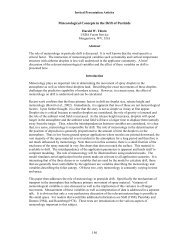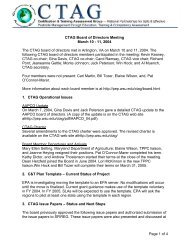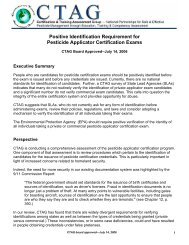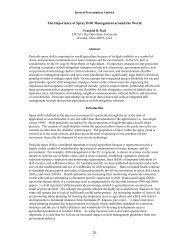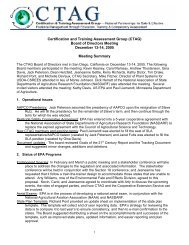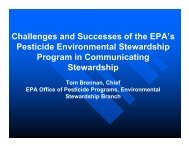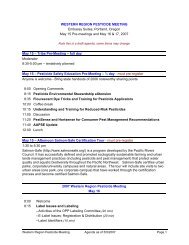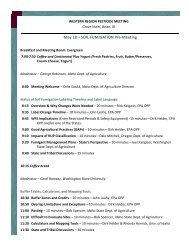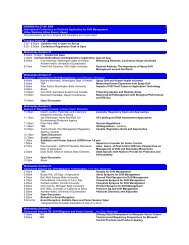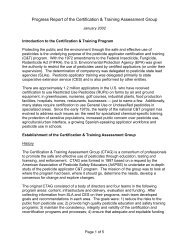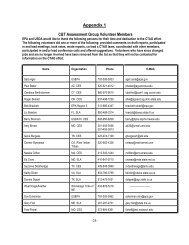309 Drift Characteristics of Boom Sprayer Nozzles Measured in a ...
309 Drift Characteristics of Boom Sprayer Nozzles Measured in a ...
309 Drift Characteristics of Boom Sprayer Nozzles Measured in a ...
You also want an ePaper? Increase the reach of your titles
YUMPU automatically turns print PDFs into web optimized ePapers that Google loves.
Poster Articles<br />
<strong>Drift</strong> <strong>Characteristics</strong> <strong>of</strong> <strong>Boom</strong> <strong>Sprayer</strong> <strong>Nozzles</strong> <strong>Measured</strong> <strong>in</strong> a W<strong>in</strong>d Tunnel<br />
Robert E. Wolf<br />
Kansas State University, Manhattan, KS 66506, USA<br />
Abstract<br />
A w<strong>in</strong>d tunnel, water-sensitive papers (wsp), and DropletScan® s<strong>of</strong>tware was used to collect and<br />
compare the movement <strong>of</strong> spray droplets downw<strong>in</strong>d from 22 different ground sprayer nozzles. The w<strong>in</strong>d<br />
tunnel was equipped with a plant canopy and a s<strong>in</strong>gle nozzle boom to simulate a field application. A<br />
constant w<strong>in</strong>d speed <strong>of</strong> 4.6 m/s was used for the test and all nozzles were <strong>in</strong>dividually tested with a<br />
perpendicular orientation to the w<strong>in</strong>d direction. Each nozzle was tested at a flow rate <strong>of</strong> 1.5 liters per<br />
m<strong>in</strong>ute and a pressure <strong>of</strong> 276 kPa. Water-sensitive papers were placed at canopy height 1, 2, and 3 meters<br />
downw<strong>in</strong>d to collect the spray droplets escap<strong>in</strong>g the spray swath. Percent area coverage for each wsp was<br />
generated by DropletScan® for comparative purposes. High amounts <strong>of</strong> coverage would support an<br />
<strong>in</strong>creased potential for spray drift. At the 1-meter location, the amount <strong>of</strong> coverage ranged from a high <strong>of</strong><br />
99 percent with traditional flat-fan nozzles to a low <strong>of</strong> 8 percent with the chamber design turf flood. The<br />
venturi nozzles as a group performed best overall with coverage’s rang<strong>in</strong>g from 36-9 percent with no<br />
significant differences <strong>in</strong> coverage found between the top seven drift reduc<strong>in</strong>g nozzles. The group mean<br />
for the venturi nozzles was 20 percent. This is compared to the flat-fan group at 90 percent, the preorifice<br />
and chamber nozzles at 42 percent, and the hollow cones at 72 percent. This study supports the use <strong>of</strong><br />
drift reduc<strong>in</strong>g nozzles as a means for m<strong>in</strong>imiz<strong>in</strong>g the potential for spray drift.<br />
Introduction<br />
Controll<strong>in</strong>g or m<strong>in</strong>imiz<strong>in</strong>g the <strong>of</strong>f-target movement <strong>of</strong> sprayed crop protection products is critical.<br />
Researchers have conducted numerous studies over time to better understand spray drift problems.<br />
Particularly, a recent group <strong>of</strong> studies conducted by the <strong>in</strong>dustries Spray <strong>Drift</strong> Task Force (SDTF, 1997)<br />
generated numerous reports to support an Environmental Protection Agency (EPA) spray drift data<br />
requirement for product reregistration and future label guidance statements on drift m<strong>in</strong>imization.<br />
Even though a better understand<strong>in</strong>g <strong>of</strong> the variables associated with spray drift exists, it is still a<br />
challeng<strong>in</strong>g and complex research topic. Environmental variables, equipment design issues, many other<br />
application parameters, and all their <strong>in</strong>teractions make it difficult to completely understand drift related<br />
issues (Smith, et al., 2000). Droplet size and spectrum has been identified as the one variable that most<br />
affects drift (SDTF, 1997). Many forces imp<strong>in</strong>ge on droplet size, but it is still the drop size that must be<br />
manipulated to optimize performance and elim<strong>in</strong>ate associated undesirable results (Williams, et al., 1999).<br />
<strong>Drift</strong> is associated with the development <strong>of</strong> high amount <strong>of</strong> f<strong>in</strong>e droplets (Gobel and Pearson, 1993).<br />
Wolf, et al., (1999, 2000, 2001, 2001) <strong>in</strong> field studies, found that commonly used flat spray nozzle types<br />
exhibited significantly different potential to drift.<br />
Over the last several years there has been an <strong>in</strong>creased <strong>in</strong>terest by nozzle manufactures to design nozzles<br />
that will effectively reduce the volume <strong>of</strong> driftable f<strong>in</strong>es found <strong>in</strong> spray droplet spectrums. This is be<strong>in</strong>g<br />
successfully accomplished with the use <strong>of</strong> a preorifice and also with turbulation chambers (R. Wolf,<br />
2000). A recent trend with spray nozzle design is to <strong>in</strong>corporate a ‘venturi’ that <strong>in</strong>cludes the spray droplet<br />
<strong>in</strong> air to lessen the drift potential while still ma<strong>in</strong>ta<strong>in</strong><strong>in</strong>g adequate efficacy. Several nozzle manufacturers<br />
are <strong>in</strong>clud<strong>in</strong>g this new design as a part <strong>of</strong> a market<strong>in</strong>g campaign for drift control. Early research would<br />
<strong>in</strong>dicate that the venturi nozzle is produc<strong>in</strong>g larger spray droplets (Womac, et al., 1997; Ozkan and<br />
Derksen, 1998; R. Wolf, et al., 1999, 2001, 2001).<br />
<strong>309</strong>
Poster Articles<br />
Spray drift data collection <strong>in</strong> the field is very complicated, expensive, and time consum<strong>in</strong>g. Efforts and<br />
techniques to use w<strong>in</strong>d tunnels to measure spray drift from various boom sprayer nozzle types are be<strong>in</strong>g<br />
developed (Phillips and Miller, 1999). W<strong>in</strong>d tunnel studies with simple nozzle mount<strong>in</strong>g structures can<br />
provide valuable nozzle performance data <strong>in</strong>dependent <strong>of</strong> a sprayer and tractor while reduc<strong>in</strong>g much <strong>of</strong><br />
the variability experienced <strong>in</strong> the field measurement process (Miller, 1993). Phillips and Miller (1999)<br />
determ<strong>in</strong>ed that w<strong>in</strong>d tunnel experiments are adequate to simulate the results <strong>of</strong> field measurements for spray<br />
drift.<br />
Objective<br />
The objective <strong>of</strong> this study was to compare <strong>in</strong> a w<strong>in</strong>d tunnel the amount <strong>of</strong> downw<strong>in</strong>d spray droplet<br />
movement (drift) from several different boom sprayer nozzles.<br />
Procedure<br />
This study was designed to measure and compare <strong>in</strong> a w<strong>in</strong>d tunnel the amount <strong>of</strong> downw<strong>in</strong>d spray droplet<br />
movement (drift) from 22 different nozzle designs (table 1). All nozzles were compared at a flow rate <strong>of</strong><br />
1.5 liters per m<strong>in</strong>ute. The spray pressure was ma<strong>in</strong>ta<strong>in</strong>ed at 276 kPa for all treatments.<br />
Table 1. Nozzle types evaluated with group, company, and spray pattern style.<br />
Nozzle Type 1 Group 2 Company Pattern Style<br />
XR8004 1 Spray<strong>in</strong>g Systems Flat-fan<br />
XR10004 1 Spray<strong>in</strong>g Systems Flat-fan<br />
TR80-04 1 Hypro Flat-fan<br />
TR110-04 1 Hypro Flat-fan<br />
DG11004 2 Spray<strong>in</strong>g Systems Preorifice Flat-fan<br />
RF4 2 Delavan Preorifice Flat-fan<br />
TKVS2 1 Spray<strong>in</strong>g Systems Flood<strong>in</strong>g Flat-fan<br />
TFVP2 2 Spray<strong>in</strong>g Systems Chamber Flood<strong>in</strong>g Flat-fan<br />
TFVS2 2 Spray<strong>in</strong>g Systems Chamber Flood<strong>in</strong>g Flat-fan<br />
TTJ04 2 Spray<strong>in</strong>g Systems Chamber Turf Flood<strong>in</strong>g Flat-fan<br />
TT11004 2 Spray<strong>in</strong>g Systems Chamber Flat-fan<br />
AI11004 4 Spray<strong>in</strong>g Systems Venturi Flat-fan<br />
TD04-XR11008 4 Greenleaf/Spray<strong>in</strong>g Systems Venturi Flat-fan<br />
AIR MIX 110-04 4 Greenleaf Venturi Flat-fan<br />
ULD 120-04 4 Hypro Venturi Flat-fan<br />
AB11004 4 Air Bubble Jet-BJ Agri Products Venturi Flat-fan<br />
RAINDROP ULTRA 4 4 Delavan/CP Venturi Flat-fan<br />
AVI110-04 4 Hypro/Albuz Venturi Flat-fan<br />
DR80-04 2 Wilger Preorifice Flat-fan<br />
TD04-TT11004 4 Greenleaf/Spray<strong>in</strong>g Systems Venturi Flat-fan<br />
RA4 3 Delavan Hollow Cone<br />
MC1.875 3 Great Pla<strong>in</strong>s Hollow Cone<br />
1 All nozzles were calibrated to spray at 1.5 liters per m<strong>in</strong>ute at 276 kPa.<br />
2 Groups: 1 = Traditional flat-fan; 2 = preorifice and/or chamber; 3 = hollow-cone; 4 = venturi<br />
Applications us<strong>in</strong>g water with a s<strong>in</strong>gle nozzle boom configured for use <strong>in</strong> a w<strong>in</strong>d tunnel were made at a<br />
constant w<strong>in</strong>d speed <strong>of</strong> 4.6 m/s throughout the experiment. Each nozzle treatment was positioned<br />
perpendicular to the w<strong>in</strong>d direction. The nozzles were located from 45 to 51cm above the canopy. A<br />
canopy, 25 cm high, was placed on the w<strong>in</strong>d tunnel floor to simulate field conditions for a postemergence<br />
spray application. The canopy consisted <strong>of</strong> plastic broadleaf plants that were placed randomly through the<br />
310
Poster Articles<br />
entire length and width <strong>of</strong> the tunnel. Simulated grass was placed on the floor <strong>of</strong> the tunnel under the<br />
boom to m<strong>in</strong>imize spray droplet bounce.<br />
Water sensitive papers (Syngetna, 2002), were placed at canopy height downw<strong>in</strong>d from the spray boom to<br />
function as collectors for the droplets mov<strong>in</strong>g away from the spray swath. Three water sensitive papers<br />
(wsp) were located at 1, 2, and 3 meters downw<strong>in</strong>d over four replications for each treatment. A flatbed<br />
scanner (HP 6200Cse, 1200 pixels, Hewlett Packard, Palo Alto, CA), a computer, and DropletScan®<br />
s<strong>of</strong>tware (WRK <strong>of</strong> Arkansas and Oklahoma, Devore Systems, Inc, Manhattan, KS) were used to capture<br />
the droplet images and generate the droplet <strong>in</strong>formation. Tests for equality <strong>of</strong> means were performed<br />
us<strong>in</strong>g PROC GLM. The nozzles were placed <strong>in</strong>to four groups based on design and pattern for further<br />
statistical analysis (table 1). The groups compared were: traditional flat-fan, preorifice and chamber flatfan,<br />
hollow-cone, and venturi flat-fan.<br />
A boom with pressure gauge was designed to position one nozzle per treatment <strong>in</strong> the w<strong>in</strong>d tunnel 14<br />
meters downw<strong>in</strong>d from the beg<strong>in</strong>n<strong>in</strong>g <strong>of</strong> the work<strong>in</strong>g section <strong>of</strong> the w<strong>in</strong>d tunnel. A QJC364 nozzle body<br />
(Spray<strong>in</strong>g Systems Co., Wheaton, IL) with a pulse width modulation (PWM) valve (Capstan Ag Systems,<br />
Inc., Topeka, KS) attached to the diaphragm check valve was used for connect<strong>in</strong>g and controll<strong>in</strong>g each<br />
nozzle. The collector was designed for removal from the w<strong>in</strong>d tunnel after each treatment to facilitate<br />
wsp removal and replacement with dry, clean wsp for the next treatment.<br />
<strong>Nozzles</strong> and wsp were placed <strong>in</strong> position for each treatment by the researcher and assistants. The PWM<br />
valve was connected to a timer and used to control the length <strong>of</strong> spray cycle. The PWM valve allowed<br />
the system to be preset to the treatment pressure for <strong>in</strong>stant and accurate spray volume control. In this<br />
study it was determ<strong>in</strong>ed that a 2-second spray <strong>in</strong>terval was needed to achieve adequate coverage to<br />
analyze the droplets on the water sensitive paper. All controls were actuated from a control room outside<br />
the w<strong>in</strong>d tunnel. The wall was equipped with a door to facilitate nozzle chang<strong>in</strong>g and a view<strong>in</strong>g w<strong>in</strong>dow<br />
to verify the equipment functioned properly.<br />
The w<strong>in</strong>d tunnel used <strong>in</strong> this study had a work<strong>in</strong>g section 17m long, 1.5m wide, and 1.9m high. A<br />
recirculat<strong>in</strong>g push-type fan (tip to tip blade measurement, 2.0 m) driven by a 93kW General Electric DC<br />
motor was used to develop the air stream. A diffuser the size <strong>of</strong> the w<strong>in</strong>d tunnel cross-section was placed<br />
at the start <strong>of</strong> the work<strong>in</strong>g end <strong>of</strong> the tunnel. The diffuser was made from steel pipe (5.1 cm <strong>in</strong><br />
circumference by 30.5 cm long) welded to form a honeycomb design. Spires, designed to <strong>in</strong>crease both<br />
the depth and turbulence level <strong>of</strong> the w<strong>in</strong>d tunnel boundary layer, were placed at the base <strong>of</strong> the diffuser.<br />
There were no adjustments to turbulence for this study.<br />
Temperature and humidity were measured us<strong>in</strong>g a Campbell Scientific CR10X probe system with data<br />
logger. The probes were positioned at boom height. Values for each, temperature – 23 degrees C and<br />
humidity – 6 percent, were averaged over the duration <strong>of</strong> the experiment. A KURZ Model 1440M air<br />
velocity meter positioned above and near the center <strong>of</strong> the boom was used to cont<strong>in</strong>ually monitor w<strong>in</strong>d<br />
velocity. W<strong>in</strong>d velocity was controlled by adjust<strong>in</strong>g the amperage to the fan motor.<br />
Results and Discussion<br />
Water-sensitive papers (wsp) are <strong>of</strong>ten used as an <strong>in</strong>dicator for the presence <strong>of</strong> spray deposition<br />
(Matthews, 1992). Water <strong>in</strong> the spray sta<strong>in</strong>s the wsp and the spot size can be observed or measured, thus,<br />
permitt<strong>in</strong>g the use <strong>of</strong> wsp to evaluate the number <strong>of</strong> droplets per unit area and for measur<strong>in</strong>g the percent<br />
area covered (Syngenta, 2002). Spray droplets mov<strong>in</strong>g downw<strong>in</strong>d and collected on water sensitive paper<br />
are a good <strong>in</strong>dicator <strong>of</strong> a spray tips potential for drift when measur<strong>in</strong>g the amount <strong>of</strong> coverage obta<strong>in</strong>ed on<br />
311
Poster Articles<br />
the cards (Wolf, 1999). One statistic generated by DropletScan® s<strong>of</strong>tware is percent area coverage.<br />
S<strong>in</strong>ce the wsp are placed outside and downw<strong>in</strong>d from each treatments swath, differences <strong>in</strong> the amount <strong>of</strong><br />
area covered on the wsp will reflect the amount spray droplets mov<strong>in</strong>g away from the swath. The percent<br />
area coverage for each nozzle treatment for the wsp positioned 1 meter downw<strong>in</strong>d are compared and<br />
presented <strong>in</strong> table 2. Figures 1 and 2 are <strong>in</strong>cluded to highlight the differences at the one meter collector<br />
location.<br />
Table 2. Coverage means for all nozzle types by nozzle, by group, and group mean 1 .<br />
WSP all locations<br />
WSP location – 1 meter downw<strong>in</strong>d<br />
312<br />
Group<br />
Mean<br />
Nozzle Type 2 1 meter 2 meters 3 meters Group1 Group 2 Group 3 Group 4<br />
tr8004 98.7 83.0 28.4 98.7<br />
tr110-04 97.3 94.8 63.2 97.3<br />
xr8004 92.7 60.4 22.1 92.7 1 = 90.4<br />
mci1.875 91.2 68.1 26.9 91.2<br />
xr11004 90.1 66.1 27.1 90.1<br />
tkvs2 72.4 54.1 26.8 72.4 2 = 42.0<br />
dg11004 72.0 57.4 20.0 72.0<br />
tt11004 64.6 35.2 16.7 64.6<br />
ra4 53.0 12.1 3.7 53 3 = 72.3<br />
tfvp2 50.7 33.4 15.2 50.7<br />
tfvs2 43.6 27.1 13.7 43.6<br />
ab11004 35.7 14.4 3.9 35.7<br />
dr80-04 30.2 8.9 2.6 30.2<br />
am110-04 27.1 9.9 3.1 27.1<br />
rf4 24.6 11.2 4.2 24.6<br />
avi110-04 20.9 8.0 3.0 20.9<br />
ai11004 18.7 8.7 2.3 18.7<br />
td04-xr11008 17.8 7.1 2.0 17.8 4 = 20.2<br />
ru-4cp 16.0 7.8 2.7 16.0<br />
td04-tt11008 15.2 4.8 1.7 15.2<br />
uld120-04 9.4 4.1 1.2 9.4<br />
ttj04 8.4 3.1 1.1 8.4<br />
1<br />
Percent area coverage on water sensitive paper. Higher coverage percentages <strong>in</strong>dicate more potential for spray<br />
drift.<br />
2 See table 1 for nozzle type manufacturer.<br />
The percent area coverage generated by DropletScan® for each nozzle treatment at the 1-meter location<br />
downw<strong>in</strong>d ranges from 98.7 to 8.4 percent. The traditional flat-fan nozzle types and the hollow cone (MC<br />
1.875) all show significantly higher coverage amounts (LSD = 12.7) than the other nozzle styles or<br />
groups. The nozzle types with less coverage represent designs for reduc<strong>in</strong>g spray drift with the venturi<br />
types show<strong>in</strong>g the least downw<strong>in</strong>d coverage. The preorifice and chamber style nozzles exhibited less<br />
coverage on the collectors than the nozzles <strong>in</strong> group 1 but more than the group 4 nozzles. Very little<br />
differences were evident with<strong>in</strong> the venturi group except for the Air Bubble (ab11004). The ab11004 had<br />
35.7 percent area coverage (LSD = 12.7) when compared to the AVI 11104 (20.9%), AI11004 (18.7%),<br />
TD04-XR11004 (17.8%), RU-4CP (16.0%), TD04-TT11004 (15.2%), and ULD120-04 (9.4%). The<br />
group mean was 20.2 percent area coverage. The ULD120-04 had the least amount <strong>of</strong> coverage for the
Poster Articles<br />
venturi group <strong>of</strong> nozzles. The chamber style turf flood had the least amount <strong>of</strong> coverage (8.4%)<br />
compared to all nozzles <strong>in</strong> the study.<br />
Nozzle Type<br />
TurfJet<br />
Ultra Lo-<strong>Drift</strong>®<br />
TurboDrop® +<br />
Ra<strong>in</strong>drop Ultra®<br />
TurboDrop® + XR<br />
AI TeeJet<br />
AVI<br />
RF Ra<strong>in</strong>drop®<br />
AirMix®<br />
DR<br />
Air BubbleJet®<br />
Turbo FloodJet® VS<br />
Turbo FloodJet®<br />
RA Ra<strong>in</strong>drop®<br />
Turbo TeeJet®<br />
DG TeeJet®<br />
TK FloodJet® VS<br />
XR TeeJet® 110<br />
mci MeterCone®<br />
XR TeeJet® 80<br />
Total Range 110<br />
Total Range 80<br />
0 10 20 30 40 50 60 70 80 90 100<br />
Percent Area Coverage<br />
Figure 1. Coverage means at 1-meter downw<strong>in</strong>d for all nozzle types. LSD=12.7<br />
Coverage Mean by Group<br />
percent area<br />
coverage<br />
100<br />
90<br />
80<br />
70<br />
60<br />
50<br />
40<br />
30<br />
20<br />
10<br />
0<br />
90.4<br />
72.3<br />
42<br />
20.2<br />
1 2 3 4<br />
Groups<br />
Figure 2. Group mean for coverage at 1-meter.<br />
313
Poster Articles<br />
Similar trends are found at the 2 and 3-meter downw<strong>in</strong>d locations (table 2). As distance from the nozzle<br />
<strong>in</strong>creased the amount <strong>of</strong> coverage decreased. With<strong>in</strong> the flat-fan group (XR and TR), the 110-degree fan<br />
angle exhibited more coverage at the farther distances than the 80-degree versions. Designs to reduce the<br />
development <strong>of</strong> smaller spray droplets, as <strong>in</strong> groups 2 and 4, exhibited less coverage with differences less<br />
significant at the second and third collector positions.<br />
Individual nozzles means with<strong>in</strong> each group are reported <strong>in</strong> table 1 and figure 2. The group 1 nozzles had<br />
the most coverage (90.4%) at 1-meter. The two nozzles <strong>in</strong> group 3 were next highest (72.3%); followed<br />
by group 2 nozzles (42%) and then the group 4 nozzles had the least amount <strong>of</strong> coverage (20.2%). This<br />
trend was true at all three locations downw<strong>in</strong>d.<br />
Conclusions<br />
Comparisons <strong>of</strong> the twenty-two nozzles types show a wide variation <strong>in</strong> the percent area coverage on the<br />
wsp downw<strong>in</strong>d from the swath. The highest amount <strong>of</strong> coverage and potential for spray drift occurred<br />
with the traditional flat-fans and the MC 1.875 hollow cone tip. The preorifice and turbulation designs<br />
were significantly lower <strong>in</strong> coverage when compared to the flat-fan nozzle types. The nozzles <strong>in</strong> group 2<br />
exhibit a significant degree <strong>of</strong> difference with<strong>in</strong> the group rang<strong>in</strong>g from 72-8.4 percent coverage. The two<br />
hollow cone designs were significantly different <strong>in</strong> coverage from each other (91.6 – 53%). The nozzles<br />
<strong>in</strong> group 4 were overall the best for reduc<strong>in</strong>g the amount <strong>of</strong> downw<strong>in</strong>d movement <strong>of</strong> spray droplets which<br />
is evidenced by the dramatically reduced amounts <strong>of</strong> coverage on the collectors.<br />
The data <strong>in</strong> this study would support that certa<strong>in</strong> nozzle designs will m<strong>in</strong>imize the creation <strong>of</strong> small spray<br />
droplets. In this study with all the variables held constant <strong>in</strong>clud<strong>in</strong>g the w<strong>in</strong>d speed significant differences<br />
are present for drift potential. <strong>Nozzles</strong> with the least amount <strong>of</strong> coverage on the water sensitive papers<br />
downw<strong>in</strong>d would be considered good choices for reduc<strong>in</strong>g the drift potential.<br />
Acknowledgements<br />
I would like to acknowledge the Manhattan, KS USDA-ARS W<strong>in</strong>d Erosion Research Unit staff for their<br />
support and use <strong>of</strong> the w<strong>in</strong>d tunnel to complete this study. I would also like to acknowledge the<br />
companies provid<strong>in</strong>g nozzles for use <strong>in</strong> this evaluation.<br />
References<br />
Gobel, B and Pearson, S. 1993. <strong>Drift</strong> Reduction by spray nozzle techniques. Second International<br />
Symposium on Pesticide Application Techniques. 219-226.<br />
Mathews, G.A. 1992. Pesticide Application Methods, 2 nd Ed. New York: Longman Scientific &<br />
Technical.<br />
Miller, P.C.H. 1993. Spray drift and its measurement. In: Application Technology for Crop Production.<br />
Matthews, G.A. and E.C. Hilsop, eds. London, CAB International.<br />
Ozkan, H.E. and R.C. Derksen. 1998. Extension Fact Sheet – Effectiveness <strong>of</strong> Turbodrop and Turbo<br />
TeeJet <strong>Nozzles</strong> <strong>in</strong> <strong>Drift</strong> Reduction. The Ohio State University, Food, Agricultural and Biological<br />
Eng<strong>in</strong>eer<strong>in</strong>g Department. AEX 524-98.<br />
Phillips, J.C. and P.C.H. Miller. 1999. Field and W<strong>in</strong>d Tunnel Measurements <strong>of</strong> the Airborne Spray<br />
Volume Downw<strong>in</strong>d <strong>of</strong> S<strong>in</strong>gle Flat-Fan <strong>Nozzles</strong>. 72. 161-170.<br />
SDTF, 1997. A Summary <strong>of</strong> Ground Application Studies, Stewart Agricultural Research Services, Inc.<br />
P.O. Box 509, Macon, MO. 63552.<br />
314
Poster Articles<br />
Smith, D.B., L.E. Bode, and P.D. Gerard. 2000. Predict<strong>in</strong>g Ground <strong>Boom</strong> Spray <strong>Drift</strong>. Trans. ASAE<br />
43(3):547-553.<br />
Syngenta. 2002. Water-sensitive paper for monitor<strong>in</strong>g spray distributions. CH-4002. Basle,<br />
Switzerland: Syngenta Crop Protection AG.<br />
Williams, W.L., D.R. Gardisser, R. E. Wolf, and R. W. Whitney. 1999. Field and W<strong>in</strong>d Tunnel Droplet<br />
Spectrum Data for the CP Nozzle. ASAE Paper No. AA99-007. St Joseph, MI.: ASAE.<br />
Wolf, R.E., D.R. Gardisser, and W. L. Williams, 1999. Spray Droplet Analysis <strong>of</strong> Air Induction<br />
<strong>Nozzles</strong> Us<strong>in</strong>g WRK DropletScan® Technology. ASAE Paper No. 991026. St. Joseph, MI.:<br />
ASAE.<br />
Wolf, R., D. Peterson, and C. M<strong>in</strong>ihan. Dec. 1999. Comparisons <strong>of</strong> <strong>of</strong>f-target deposits for conventional<br />
postemergence spray nozzles and venturi nozzles. Proceed<strong>in</strong>gs North Central Weed Science<br />
Society. 54:70.<br />
Wolf, R., 2000. Fact Sheet - Equipment to Reduce Spray <strong>Drift</strong>. Application Technology Series.<br />
Biological and Agricultural Eng<strong>in</strong>eer<strong>in</strong>g Dept., Kansas State University. MF-2444.<br />
Wolf, R., 2000. The Influence <strong>of</strong> Chang<strong>in</strong>g Application Volumes on Droplet Size Us<strong>in</strong>g Blended Pulse<br />
Spray<strong>in</strong>g Technology. ASAE Paper No. 001122. St. Joseph, MI.: ASAE.<br />
Wolf, R., D. Peterson, and C. M<strong>in</strong>ihan. Dec. 2000. Influence <strong>of</strong> Spray Droplet Size On Paraquat and<br />
Glyphosate Efficacy. Proceed<strong>in</strong>gs North Central Weed Science Society. 55:116-17.<br />
Wolf, R. and C. M<strong>in</strong>ihan. March 2001, Comparison <strong>of</strong> <strong>Drift</strong> Potential for Venturi, Extended Range, and<br />
Turbo Flat-fan <strong>Nozzles</strong>. ASAE Paper No. MC01-108. St. Joseph, MO.: ASAE Sponsored.<br />
Wolf, R., D. Peterson, and C. M<strong>in</strong>ihan. Dec. 2001. Influence <strong>of</strong> Nozzle Type and Spray Pressure on<br />
Droplet Size. Proceed<strong>in</strong>gs North Central Weed Science Society. 56:Paper No. 142.<br />
Womac, A.R., J.C. Goodw<strong>in</strong>, and W.E. Hart. 1997. Tip Selection for Precision Application <strong>of</strong> Herbicides,<br />
University <strong>of</strong> Tennessee CES. Bullet<strong>in</strong> 695.<br />
315



